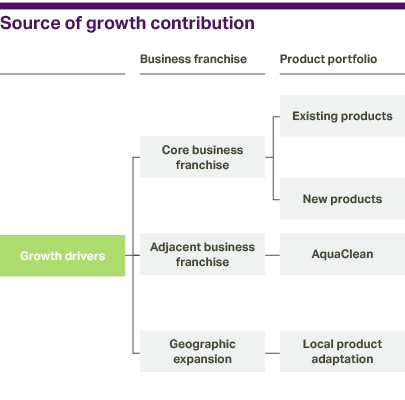
Business report > Business and financial review
Targets and strategy
Ambitious medium-term goals
Geberit has made the setting of standards in sanitary technology worldwide its goal and aims to entrench these standards in the long-term by acting sustainably. This approach is to be reflected among other things in sales growth that outstrips the industry average. Basically, Geberit is aiming to achieve its sales targets while at the same time maintaining its industry leadership in terms of profitability and the ability to generate high cashflows. Additional growth through acquisitions has not been ruled out. However, any potential acquisition will have to satisfy strict strategic and financial criteria. In the medium term, average currency-adjusted sales growth of 4 to 6% and an operating cashflow margin of between 23 and 25% should be achieved annually.

Medium-term contributions to growth will come from products already launched on the market, new product launches, the AquaClean business and from local product adaptations. Overall, around one-third of growth should result from products that have been launched in the past three years and from the AquaClean business.
Having achieved the project objectives, the organic growth initiatives (OGls) in sales launched over the past few years became an integral part of standard business once again in 2013 and will no longer be measured and disclosed separately. These initiatives are generating substantial contributions to growth, which shall pave the way for continued above-average growth and market share gains.
A concerted internationalization strategy for the AquaClean business has been pursued since the beginning of 2009 with the objectives of establishing shower toilets as a product category in Europe and strengthening Geberit’s position as the market leader in this category.
In addition, further contributions to growth will be generated in the context of geographic expansion from products adapted to the specific local needs outside the core European markets.
In order to be prepared for the expected growth, Geberit also intends to invest around CHF 100 million annually in property, plant and equipment in the coming years.
Strategy
In accordance with its vision, Geberit aims to achieve sustained improvement in the quality of people’s lives through innovative solutions in sanitary technology. Its proven, focused strategy for doing so is based on the four strategic pillars “Focus on sanitary technology”, “Commitment to innovation”, “Selective geographic expansion” and “Continuous optimization of business processes”. These are practiced daily by the highly motivated and qualified employees.
- With regard to focusing on sanitary technology, Geberit centers on those business areas in the sanitary industry for which in-depth know-how and core competencies are available within the company. Essentially, these are sanitary systems and piping systems for the transport of water in buildings. Here, superior-quality, integrated, water-saving sanitary systems are offered.
- Continuously optimizing and extending the product range is crucial for future success. Innovation strength is founded on basic research in areas such as hydraulics, statics, fire protection, hygiene and acoustics. The insights gained are systematically applied in the development of products and systems for the benefit of customers.
- The accelerated penetration of markets such as France, the United Kingdom, the Nordic Countries, Eastern Europe and the Iberian Peninsula is an important factor for long-term success. Outside Europe, Geberit concentrates on the most promising markets. These include North America, China, Southeast Asia, Australia, the Gulf region and India. With the exception of North America and Australia, the company mainly engages in project business in these regions. In this respect, the company always adheres strictly to the existing high standards in terms of quality and profitability.
- A further strategic focus relates to the permanent optimization of business processes. This is intended to ensure a leading, competitive cost structure in the long-term and is partly achieved through Group-wide projects and partly through employees identifying improvement potential in their day-to-day work, thus making a major contribution toward positive development.
Strategic success factors
The success of the Geberit Group is based on a series of success factors. The most important are:
- a clear, long-term strategy,
- the focus on the sanitary industry,
- significant sustainable growth drivers (refer to graphic → “Source of growth contribution”),
- an attractive competitive position,
- an innovative product range, developed in accordance with customer needs,
- a proven push-and-pull business model,
- a stable management structure,
- a lean, high-performance organization with optimized processes.
Value-oriented management
Value orientation aspects are considered in many areas of the company.
The remuneration model for Group management as a whole involves a remuneration portion that is dependent on the company’s performance and which is calculated on the basis of four equally weighted key figures – including the return on operating capital. In addition to the salary, there is an annual option plan for the Group Executive Board and other management members. Allotments under the option plan are also linked to a target figure for return on operating capital. Details can be found in the → Remuneration Report and in the → Corporate Governance section.
Investments in property, plant and equipment above a certain amount are approved only if strict criteria are met. In this context, it is mandatory that an investment return be achieved that exceeds the cost of capital plus a premium.
In the interests of value-oriented management, Group-relevant projects are tracked over the long-term following project completion and the achievement of objectives is evaluated. To this end, a controlling report is discussed annually by the Group Executive Board.
